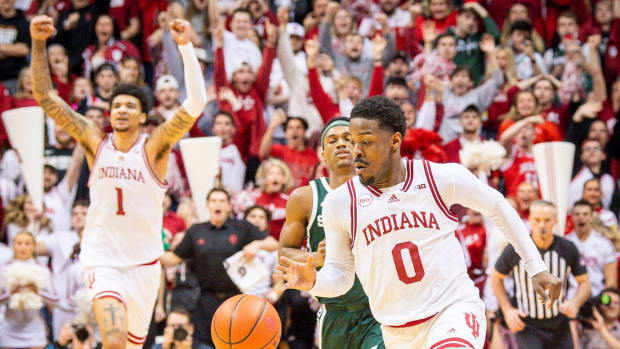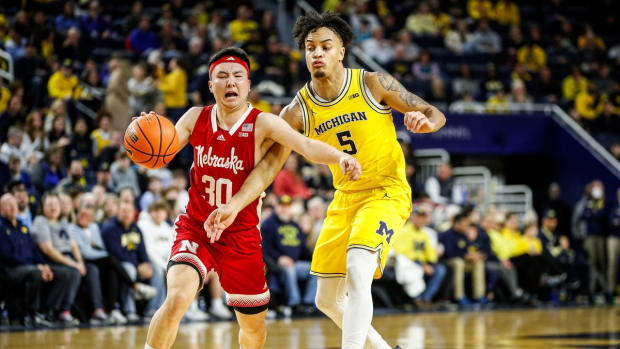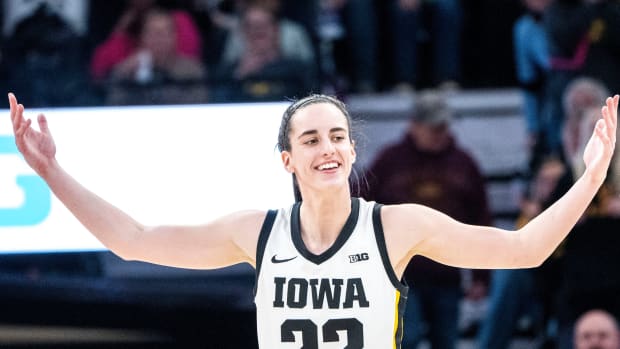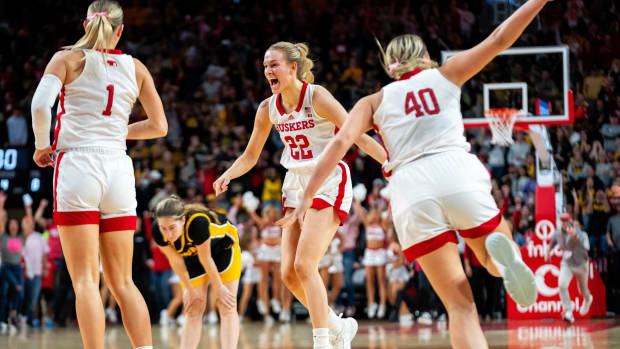Analytics Tracker: Week 2 Statistical Deep Dive
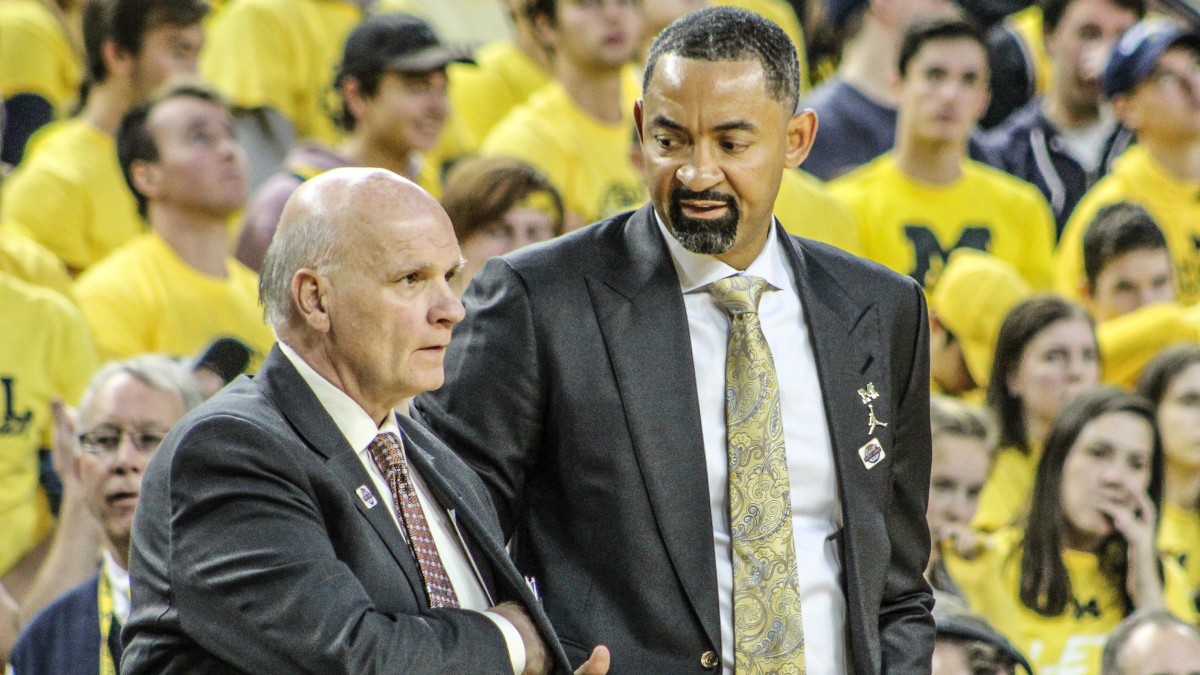
Michigan looked like a more comfortable, confident team during the second week of the season, resulting in two double-digit victories. In turn, the Wolverines jumped six spots to No. 25 in the country according to KenPom’s rating system (as of Nov. 17). With a gauntlet of difficult matchups looming over the next two weeks before heading into the conference slate, there are both positive statistical trends emerging for head coach Juwan Howard and his team to build upon and lingering areas of concern to address.
Here is a look at notable player-specific trends and advanced stats through two weeks of the season using the KenPom statistical model. If you are unfamiliar with KenPom and its metrics, you can read a quick primer here.
*To qualify for individual conference rankings, players must log between 40 percent and 60 percent of possible minutes played, depending on the metric.
Key Trends:
•The Wolverines, who were plagued with long-scoring droughts in their exhibition win over Saginaw Valley State and season-opening victory against Appalachian State, mitigated these woes during the second week of the season. Their longest stretch without points against Creighton was 3:29, and they experienced a 4:28 scoreless streak in the first half against Elon. Aside from these two stretches, U-M did not go more than three minutes at any given time without lighting up the scoreboard.
•Turnovers continue to be an issue for Michigan, with its 18.4 Turnover Rate (TORate) ranking 123rd in country according to KenPom. Individually, senior point guard Zavier Simpson (26.2 TORate, 82nd Big Ten) and junior forward Isaiah Livers (22.5 TORate, 71st Big Ten) have been uncharacteristically careless with the ball. Although he has not logged enough minutes to qualify for KenPom rankings, sophomore center/forward Colin Castleton’s 30.0 TORate is the worst on the team.
•Howard continued to employ an eight-man rotation during the second week of the season with only six Wolverines seeing significant playing time of at least 40.0 percent of possible minutes played (%Min). Livers, Simpson and junior guard Eli Brooks have all logged at least 80.0%Min this season.
•Of these eight players seeing significant action, seven have an Effective Field Goal Percentage (eFG%) of 50.0 or better, which is considered above average by KenPom standards. Livers’ 65.2 eFG% (10th Big Ten) leads the pack, with Brooks a close second with a 62.1 eFG% (11th Big Ten). Sophomore guard David DeJulius (57.7 eFG%, 15th Big Ten) and senior center Jon Teske (57.4 eFG%,16th Big Ten) also rank in the top 20 in the conference.
Michigan’s 57.8 eFG% as a team is good for second-best in the Big Ten and 27th best in the country.
•U-M has struggled on the glass, with a 24.2 Offensive Rebound Percentage (OR%) that is the second-worst in the league and ranks 279th in nation. Howard’s squad has also allowed its opponents to amass a 30.0 rating in the metric, which places them 13th in conference and 215th in the nation. In three games this season, they have yielded 11.0 offensive rebounds per game while grabbing 7.3 of their own.
•The Wolverines have been tremendous in defending the three-point line. Only 24.3 percent of shots taken by opponents have been from beyond the arc, the lowest 3-Point Attempt Percentage (3PA%) in the Big Ten and third lowest in the nation.
•Michigan’s average time of possession of 17.0 seconds is a full 1.5 seconds less than a year ago, but it ranks only 8th in the conference and 173rd in the country. In its last two contests, Howard’s team is averaging only three points per game in transition.
Starting 5
Point Guard: Senior Zavier Simpson
Traditional Stat Line (Per Game Averages): 11.3 points, 7.3 assists, 4.3 rebounds,
After a disastrous first-game of the season, Simpson has started to return to form. His Offensive Rating (ORtg) has improved to a respectable 100.0, and his Assist Rate (ARate) is the fourth-best in the Big Ten at 38.6. Simpson has never never finished a season with an ORtg of below 100.6, and his best ARate was 36.4 during his junior campaign.
Shooting Guard: Junior Eli Brooks
Traditional Stat Line (Per Game Averages): 13.7 points, 2.7 assists, 1.3 rebounds
Brooks’ hot start continued through the second week of the season, and he currently ranks in the top 15 in the conference in %Min (83.3, 5th Big Ten), 3P% (47.1, 9th Big Ten) and eFG% (62.1, 11th Big Ten).
Small Forward: Sophomore Adrien Nunez
Traditional Stat Line (Per Game Averages): 4.3 points, 0.0 assists, 0.0 rebounds
Nunez continues to see limited minutes (34.2%Min), despite starting all three games this season. While his 100.8 ORtg is considered slightly above average by KenPom, he is the only Michigan regular that has not assisted on a single basket or collected a rebound this year despite playing in 30% of available minutes at the small forward position.
Power Forward: Junior Isaiah Livers
Traditional Stat Line: 15.0 points, 0.7 assists, 3.7 rebounds
Livers leads the Wolverines with 85.8%Min (3rd Big Ten) and a 65.2 eFG% (10th Big Ten). Although he has occupied 55% of the Wolverines’ available power forward minutes and 31% of possible minutes at small forward, both his 5.1 Offensive Rebound Percentage (OR%) and 7.4 Defensive Rebound Percentage (DR%) are both considered well below average by KenPom standards.
Center: Senior Jon Teske
Traditional Stat Line: 16.7 points, 1.3 assists, 9.0 rebounds
Following a strong performance against Appalachian State, Teske’s role in the U-M offense has increased over the last two games from a usage standpoint. His %Poss jumped from the fifth-best on the Wolverines (19.9) to the second-highest (24.7). The senior’s 124.8 ORtg is second-best in the Big Ten among players with at least a 24%Poss score.
Off the Bench
Sophomore Guard David DeJulius
Traditional Stat Line: 6.3 points, 1.3 assists, 5.7 rebounds
DeJulius is steadily growing into his role as Michigan’s sixth-man, increasing his scoring output in each game this season. He leads Michigan bench players with a 110.2 ORtg, paces all Wolverines with 46.1 Free Throw Rate (FTRate) and improved his eFG% to 57.7 with two solid performances during the second week of the season.
Sophomore Forward Brandon Johns Jr.:
Traditional Stat Line: 4.0 points, 0.3 assists, 2.7 rebounds
Despite a team-worst 45.5 eFG%, Johns maintains a 101.7 ORtg because of solid grades in the other offensive efficiency metrics—most notably his 7.9 TORate (7th Big Ten). Defensively, he ranks 12th in conference with a 6.58 Block Percentage (Blk%).
Sophomore Center/Forward Colin Castleton:
Traditional Stat Line (Per Game Average): 4.0 points, 0.7 assists, 3.7 rebounds
Many predicted a breakout year for the sophomore big man, but his time on the court thus far has been extremely limited with a team-low 25.8%Min. This can be, at least in part, attributed to his team-worst 30.7 TORate and 6.5 fouls committed per 40 minutes played. He has excelled on the defensive glass, however, pacing the Wolverines with a 31.7 DR%. He has not played enough minutes to qualify for KenPom’s player rankings.
KenPom Most Frequent Lineup Combinations (through three games):
1. Simpson, Brooks, DeJulius, Livers, Teske — 26.5%
2. Simpson, Brooks, Nunez, Livers, Teske — 21.3%
3. Brooks, DeJulius, Livers, Johns, Castleton — 6.0%
4. Simpson, DeJulius, Livers, Johns, Teske — 5.9%
5. Simpson, Brooks, DeJulius, Johns, Teske — 5.8%
KenPom Depth Chart (through three games):
PG: Simpson (80%), Brooks (19%)
SG: Brooks (65%), DeJulius (32%)
SF: DeJulius (38%), Livers (31%), Nunez (30%)
PF: Livers (55%), Johns (41%)
C: Teske (77%), Castelton (23%)
What stands out to you? Which numbers are most important moving forward? Comment below!!!

